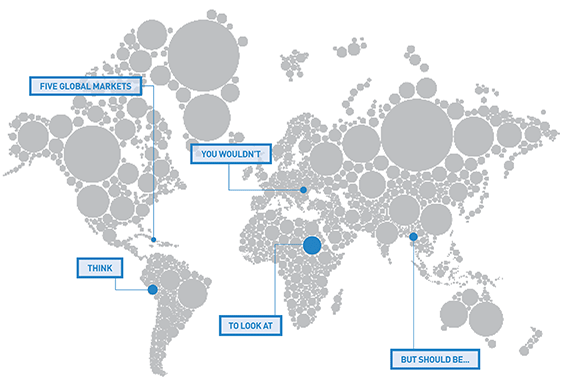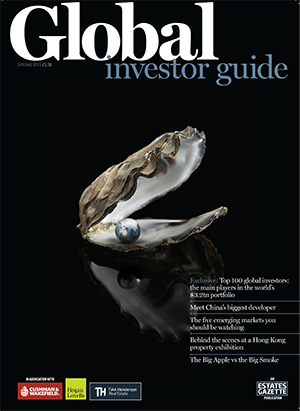The key to investment success is not just about picking the right growth markets, It is about getting to them first. Katie Puckett considers five surprising up-and-coming overseas markets that might not yet be on your radar
AFRICA
ADDIS ABABA, ETHIOPIA
Could be the next… Lagos
By… MIPIM 2020
Why?
Addis Ababa is way behind established investment destinations such as Nairobi in Kenya or Accra in Ghana. But like Nigeria’s largest city, Lagos, it is the gateway to a vast, 90m-strong untapped market with growing purchasing power. Ethiopia is already attracting corporates and its manufacturing sector is relatively advanced, with Unilever, Diageo, SAB Miller and Heineken all establishing bases there.
“Around one quarter of households in Addis Ababa have an income of more than $500 (£329) per month, so there’s massive potential for retail, but hardly any shopping centres,” says James Whitmee, director of EMC Real Estate and consultant to Knight Frank.
Infrastructure is typically the weak spot for emerging markets, but Ethiopia is in the throes of a construction boom as the government invests around 10% of its annual GDP in roads, railways and power generation. Addis also has a new, Chinese-funded light rail system and is an important airport hub for links between Africa and Asia.
What is there now?
Addis Ababa may be a city of cranes, but there’s no investment-grade real estate yet. “The supply of office buildings is very poor quality, and it’s very difficult to find buildings with everything that international corporates require,” says Whitmee. Developers typically stick to a tried-and-tested formula, with office space above three or four levels of shops. “That just doesn’t work for a corporate,” says Whitmee. “If you could build a standalone business park, you’d hoover up all the international corporates in the market.”
What are we waiting for?
The outcome of May’s elections, and an anticipated lifting of restrictions. Foreign firms are not allowed to operate in key sectors such as banking, telecoms and financial services, but once they are, demand is set to explode. “If it happens, it’ll happen very quickly,” predicts Whitmee. “Assuming the elections go well, there’ll be a lot of people heading there to make money.”
EUROPE
BELGRADE, SERBIA
Could be the next… Budapest
By… MIPIM 2025
Why?
In a continent that offers few surprises for investors, Belgrade is very definitely underdeveloped. It is the missing link – a sizeable market in a key location. “You can get to more locations in south-east Europe within nine hours’ drive from Serbia than anywhere else,” says Damian Harrington, head of Eastern Europe research at Colliers International.
Belgrade has lagged behind neighbouring cities – notably Bucharest, which caught the tail-end of the last boom. “Serbia is the next level,” says Harrington. “There has been very limited development, but it’s ripe for investors at the more opportunistic end of the spectrum.”
If it can find its own niche, it could copy the success of the Hungarian capital, Budapest, just up the Danube. The Serbian government has introduced reforms to drive growth and the country is becoming a manufacturing and outsourcing destination. Fiat has set up a production plant, and companies including Dr Oetker and Calzedonia have moved their offices to Belgrade as wages rise elsewhere in eastern Europe. Chinese prime minister Li Keqiang spent three days there in December, planning a high-speed Belgrade-Budapest rail link as part of a trade corridor between China and Europe.
What is there now?
Big opportunities for commercial real estate developers. Office vacancy rates stand at around 5-10%, and Belgrade has just two modern shopping centres. “There are huge gaps compared with western European countries,” says Jovan Vujic, associate director at Savills Coreside.
What are we waiting for?
At MIPIM 2014, Abu Dhabi’s Eagle Hills unveiled the €4bn (£3bn) Belgrade Waterfront development, with 1.8m m2 of offices, shops, residential and a 50-storey tower. For Vujic, this is the key that could finally unlock the city’s potential: “In three to five years, Belgrade could become the centre of the entire Balkans area for real estate,” he says. It has yet to move off the drawing board, but momentum is expected to pick up this year.
SOUTH AMERICA
LIMA, PERU
Could be the next… Los Angeles
By… MIPIM 2027
Why?
Like many of its neighbours, Peru offers strong GDP growth, galloping urbanisation and an increasingly middle-class population. What sets it apart is the most liberal economic laws in Latin America – its constitution gives foreigners the same rights as citizens and imposes no restrictions on foreign direct investment. Peru was also identified as one of the top improvers in JLL’s Global Real Estate Transparency Index for 2014.
Lima is roughly the size of London, but as a sprawling, coastal conurbation with a major port, it is not dissimilar to Los Angeles, albeit still lacking an equivalent of Hollywood glamour. How Peru develops will partly depend on global oil prices, but it also presents a compelling demographic case – the country experienced a baby boom around 15 years ago, and those new citizens are now entering the labour market.
What is there now?
According to Eric Rey de Castro, Colliers’ managing director in Peru, the country has a deficit of approximately 2m homes. “Ten years ago, we did not even have mortgages,” he says. “Now everyone offers you a lower down-payment, a lower rate, a longer period.” While Germany’s population is predicted to drop from 80m to 69m by 2050, Peru’s is set grow from 29m to 40m, prompting Rey de Castro to ask: “Where would you build new shopping centres and residential buildings? There are huge opportunities in every sector.”
There has indeed been a boom in shopping centre development, luring US and European brands, and now there has been a surge in office development. In 2013, office vacancy rates stood at just 1%, and 2014 saw record demand of 90,000 m2, against delivery of 120,000 m2. But by the end of 2016, the city’s total stock will have expanded by 70%. “Demand is steady, but developers have been too bullish,” says Rey de Castro. “But real estate is a long-term game and Peru is still the place to be.”
What are we waiting for?
As Lima moves into its next up-cycle, that may be the cue for investors, says Jeremy Hill, director of global research at JLL. “We see opportunities there within the next five years. It’s easier to navigate than many markets and the business operating environment is showing strong improvement – it’s the standout market in the region.”
NORTH AMERICA
HAVANA, CUBA
Could be… Miami’s twin across the water
By… MIPIM 2030
Why?
Why not? Since December’s shock announcement of a Pope-brokered détente between the US and Cuba, there’s a sense that anything is possible. The legacy of the Cold War finally appears to be thawing, as US citizens can visit the country and spend money there for the first time in more than half a century. How long will property investors be able to resist?
“People are talking about it since the softening in diplomatic relations,” says Guy Benn, director of cross-border investment at Savills Studley in New York. “There really hasn’t been any private investment for more than 50 years, so you could definitely see some outsize returns.”
President Raúl Castro has been gradually liberalising the economy since 2008, and is targeting 7% growth (compared with 2.7% in 2013). Cuba needs at least $2bn of inward investment each year, and has passed a law to attract foreign investors with tax breaks and greater security.
What is there now?
Not much, and you can’t necessarily buy it anyway. Cuba’s property market needs many reforms and the activities of foreign buyers are restricted. It’s a defiantly eccentric place – the sale of private homes was re-legalised in 2011, but acting as an estate agent was still banned until September 2013.
Tourism will be the primary driver, but South American developers are already watching the market and wealthy Cuban expats in Miami can finally invest openly. This, as well as similarities in culture and climate, could see Havana become the US city’s “exotic twin” suggests David Hutchings, head of EMEA investment strategy at Cushman & Wakefield. “It’ll be five years before you start to see anything happening.”
For institutional investors, Cuba is likely to remain rather too exotic for many years to come. “You can still see
the bullet holes from the revolution,” says one analyst. “There’s a long way to go before it’s got a fully functioning office market.”
What are we waiting for?
Much will depend on Cuba’s own internal politics – Raúl Castro is 83 – and on the progress of the diplomatic thaw. “If the US supports Cuba rather than holding it back, it could almost happen quite quickly,” says the analyst. “But I can’t see the US openly supporting a communist state.”
ASIA-PACIFIC
YANGON, MYANMAR
Could be the next… Bangkok
(without the R&R)
By… MIPIM 2035
Why?
After 50 years of military dictatorship, Myanmar is slowly reopening for business. The government is removing restrictions on foreign companies and the US has begun to lift economic sanctions. Yangon, its main commercial city, is receiving plenty of interest from corporates and Asian investors, not to mention a high-profile visit from US president Barack Obama last November.
Myanmar is one of Asia’s poorest countries, but it was once a leading economy for the region and the world’s largest rice exporter. It is rich in a range of natural resources, but it also has a population of 53m potential consumers, a growing industrial sector and major tourism potential. “Myanmar ticks a lot of boxes,” says Tony Picon, managing director of Colliers’ Yangon office, established in 2013. “There’s a lot of potential for growth, it’s not just one sector.”
What is there now?
Beautiful, but mostly dilapidated, historic buildings, and a chronic shortage of modern, high-quality property. Yangon is crying out for offices, serviced apartments and hotels – its office supply is 130,000 m2, compared to 8m m2 in Bangkok. Demand is constrained by market restrictions, as foreign companies are still shut out of industries such as banking and insurance. “They can only have a representative office, so lots of companies are setting up and taking 50-100m2,” says Picon. “Once the government gives the green light, the whole market will move. We’ve already seen that in telecoms.”
What are we waiting for?
Apart from market reforms, all eyes are on the general election later this year. If – a sizeable if – they run smoothly, it will be full steam ahead for developers and investors. “If it moves forward in the right way, there’s a lot to look forward to, for two generations,” says Picon. “Myanmar has a rich legacy – why can’t it come back? In some ways, the sky’s the limit.”
Click here for more in depth global coverage in EG’s new Global Investor Guide












